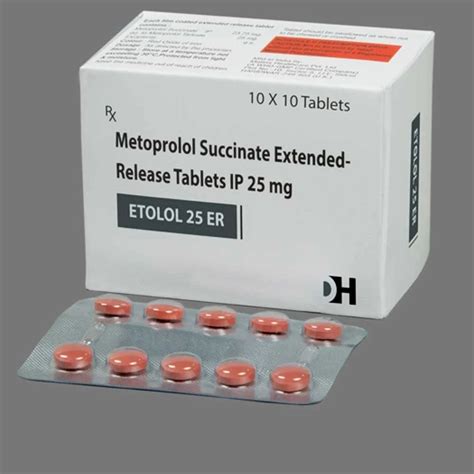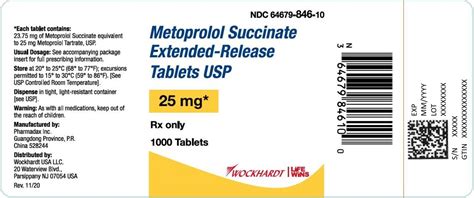Intro
Discover Metoprolol Succinate side effects, including common symptoms like dizziness, fatigue, and nausea, as well as rare effects like bronchospasm, and learn how to manage them with medical guidance and lifestyle adjustments.
Metoprolol succinate is a medication commonly used to treat high blood pressure, chest pain, and certain heart-related conditions. It belongs to a class of drugs known as beta blockers, which work by slowing the heart rate and reducing the force of the heart's contractions. While metoprolol succinate is generally effective in managing these conditions, it can cause a range of side effects, some of which can be severe. In this article, we will delve into the potential side effects of metoprolol succinate, exploring their causes, symptoms, and management strategies.
The importance of understanding the side effects of metoprolol succinate cannot be overstated. By being aware of the potential risks associated with this medication, patients can take steps to minimize their impact and ensure the safe and effective management of their condition. Furthermore, healthcare providers can use this knowledge to make informed decisions about treatment plans and to provide patients with the guidance and support they need to navigate any challenges that may arise.
As with any medication, the side effects of metoprolol succinate can vary widely from person to person. Some individuals may experience mild and temporary side effects, while others may encounter more severe and long-lasting effects. Common side effects of metoprolol succinate include dizziness, lightheadedness, and fatigue, which can be caused by the medication's impact on blood pressure and heart rate. Other potential side effects include shortness of breath, swelling in the feet and hands, and changes in sleep patterns.
Introduction to Metoprolol Succinate

Benefits of Metoprolol Succinate
The benefits of metoprolol succinate are numerous and well-documented. By reducing blood pressure and heart rate, this medication can help to lower the risk of heart attack, stroke, and other cardiovascular events. Metoprolol succinate can also help to improve symptoms of angina, such as chest pain and shortness of breath, and can reduce the risk of sudden death in patients with heart failure. Additionally, metoprolol succinate has been shown to be effective in reducing the risk of complications in patients with certain cardiac conditions, such as atrial fibrillation and ventricular arrhythmias.Common Side Effects of Metoprolol Succinate

These side effects can be caused by the medication's impact on blood pressure and heart rate, as well as its effects on other bodily systems. In most cases, these side effects are mild and temporary, and can be managed with lifestyle changes and other interventions.
Severe Side Effects of Metoprolol Succinate
While rare, metoprolol succinate can cause severe side effects that require immediate medical attention. These include: * Allergic reactions, such as hives and itching * Severe shortness of breath and wheezing * Chest pain and palpitations * Fainting and loss of consciousness * Abnormal heart rhythms and cardiac arrestIf you experience any of these symptoms, it is essential to seek medical attention immediately. Your healthcare provider can help to determine the cause of the side effect and provide guidance on how to manage it.
Managing Side Effects of Metoprolol Succinate

Your healthcare provider can also provide guidance on how to manage side effects, and can adjust your treatment plan as needed to minimize their impact.
Interactions with Other Medications
Metoprolol succinate can interact with other medications, including: * Other beta blockers and blood pressure medications * Medications for diabetes and thyroid conditions * Anti-anxiety and antidepressant medications * Pain relievers and anti-inflammatory medicationsIt is essential to inform your healthcare provider about all medications you are taking, including over-the-counter medications and supplements. This can help to minimize the risk of interactions and ensure the safe and effective management of your condition.
Precautions and Warnings

By being aware of these precautions and warnings, patients can take steps to minimize their risk and ensure the safe and effective management of their condition.
Patient Education
Patient education is essential for the safe and effective management of metoprolol succinate. This includes: * Understanding the benefits and risks of the medication * Knowing how to take the medication correctly * Being aware of potential side effects and interactions * Informing healthcare providers about any concerns or questionsBy taking an active role in their care, patients can help to ensure the safe and effective management of their condition, and can minimize the risk of complications.
Conclusion and Future Directions

What is metoprolol succinate used for?
+Metoprolol succinate is used to treat high blood pressure, chest pain, and certain heart-related conditions.
What are the common side effects of metoprolol succinate?
+Common side effects of metoprolol succinate include dizziness, lightheadedness, and fatigue, as well as shortness of breath, swelling in the feet and hands, and changes in sleep patterns.
How can I manage the side effects of metoprolol succinate?
+Side effects of metoprolol succinate can be managed with lifestyle changes, such as increasing physical activity and improving diet, as well as stress reduction techniques and getting enough sleep.
Can I take metoprolol succinate with other medications?
+Metoprolol succinate can interact with other medications, including other beta blockers and blood pressure medications, medications for diabetes and thyroid conditions, anti-anxiety and antidepressant medications, and pain relievers and anti-inflammatory medications. It is essential to inform your healthcare provider about all medications you are taking.
What precautions should I take when taking metoprolol succinate?
+Precautions include informing your healthcare provider about any heart conditions, allergic reactions, or pregnancy and breastfeeding, as well as being aware of potential side effects and interactions.
We hope this article has provided you with a comprehensive understanding of metoprolol succinate and its potential side effects. If you have any questions or concerns, please do not hesitate to reach out to your healthcare provider. Additionally, we encourage you to share this article with others who may be interested in learning more about metoprolol succinate and its uses. By working together, we can promote greater awareness and understanding of this important medication, and help to ensure the safe and effective management of cardiovascular conditions.
